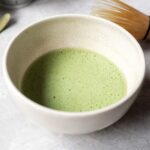How to Make Matcha
A Tea Sommelier's guide to making matcha like a pro.
Servings: 1 serving
Ingredients
- 1 teaspoon matcha or 2 matcha scoops
- ¼ cup water + more to warm bowl
Instructions
- Boil water.Green tea is very tricky when it comes to water temperature. Use simmered water, not boiling hot. Use an electric kettle with a temperature setting to get the correct water temperature. Boil more than needed since you want extra to warm up the teapot.
- Warm up bowl and rinse matcha whisk.Pour hot water into the bowl halfway and swirl the hot water around. Dip the whisk and move it around to soak the tips to soften them. Pour out the water and dry the bowl using a clean cloth or paper towel.
- Scoop and sift matcha into the warmed up bowl.Place a mesh strainer over the dry matcha bowl and using the matcha scoop, put matcha into the strainer. Sift matcha, using the scoop to help sift.
- Pour 2 tablespoons of hot water into the bowl and whisk.This step is a make sure you don't have clumps and it's essentially making a matcha paste. Move the whisk around slowly in half circles until all clumps are gone.
- Add 2 more tablespoons of hot water. Whisk vigorously.Hold the handle of the whisk using your thumb and index finger, holding the whisk upright. Use the rest of the fingers to rest to support the whisk. The whisking movement should come from the wrist. Briskly move the whisk in a zig-zag or a “W” shape. You want to make around 10-15 W’s. You can also push any bubbles to the side of the bowl to pop.
- Drink from the bowl.Matcha is meant to be sipped using both hands. Place your left hand under the bowl and your right hand rounding the side of the bowl. Traditional matcha in a bowl is meant to be finished in three sips.
Notes
- Matcha quality is easy to tell by just looking at the color. The more vibrant green the matcha, the better the quality, and more expensive. For recipes or matcha lattes, look to spend $20-$30 and for making matcha only with water, get higher quality matcha in the $30-$50 range.
- Ceremonial and cooking grade matcha are labeled for marketing purposes only. These labels don’t exist in Japan. The more expensive matcha is usually ceremonial grade and that’s the one you want when drinking it straight with just hot water.
- The secret to making a proper bowl of matcha is practice. When you whisk for the first time, the bubbles you create in the matcha froth will be on the bigger side, but the more you practice, the bubbles will get smaller. The size of the bubbles indicate right away how good someone is at making matcha.
- Make matcha using good quality water for a better, cleaner taste. I recommend using filtered water for making any kind of tea.
- Matcha is meant to be sipped directly from the bowl using both hands. Place your left hand under the bowl and your right hand rounding the side of the bowl. Traditional matcha in a bowl is meant to be finished in three sips.
- The whisks from Japan are made from bamboo that are treated with care so that the tines are super flexible yet strong. The flexibility makes it easier to create the froth. When starting out, get inexpensive matcha whisks made in China or Korea since you may destroy it quickly from improper whisking like scraping the whisk against the bottom of the bowl.
- When you first use your whisk, make sure to soak it in warm water for about 5 minutes to soften the tips. Try not to get the handle of the whisk wet, only the bottom below the dark thread.
- Don’t store your whisk in the plastic container it came in. You need to let it air dry so either leave it upright or get a matcha whisk holder.
- To clean the matcha whisk properly, either whisk it in clean hot water or run it under the faucet, being careful not to get the handle wet. After the rinse, take your thumb, index and middle finger and gather the center tines on the inside and give it a small twist to separate the outer and inner tines.
- Never get the bamboo scoop wet. It can warp the scoop so that it flattens out the end. Instead of cleaning it with soap and water, all you need to do is wipe off any matcha residue using a dry paper towel or cloth.
- Store matcha at room temperature or in the refrigerator. (Bring the matcha to room temperature before using.) Either way, make sure it is kept in an opaque, airtight container away from moisture, heat, and light. This will retain the color and quality as long as possible. It is recommended that after you open the package, matcha should be consumed within 6 months.
Nutrition
Calories: 12 | Protein: 2g | Sodium: 3mg | Vitamin A: 200IU | Calcium: 2mg | Iron: 1mg
